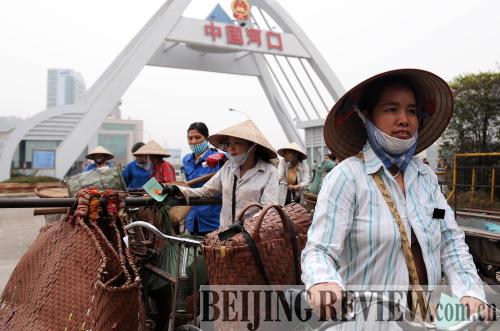|
 |
|
CROSS-BORDER TRADE: Border trade between Guangxi Zhuang Autonomous Region in south China and Viet Nam has become brisk in recent years. In this photo, Vietnamese who live near the border await entry into China via the Customs (XINHUA) |
Lai Kim is chairman of Binh Tan Consumer Goods Manufacturing Ltd. in Viet Nam's Ho Chi Minh City. Producing rubber slippers, as well as polyurethane and foam shoes, his company began exporting products to China over a decade ago. Via its agent in Guangxi Zhuang Autonomous Region in south China, Binh Tan can sell its products to other parts of China.
Every year, the company exports about 20 percent of its products to China at a value of at least $1 million. Its exports to China have grown fast within the last six years. They surged 30 percent in 2008 alone. "Our products are more and more popular in China," Lai Kim told Beijing Review.
Viet Nam has been the biggest trading partner of Guangxi. According to figures released by the Department of Commerce of Guangxi Zhuang Autonomous Region, in 2008, the foreign trade volume of Guangxi was $13.28 billion, with $7.35 billion of exports and $5.93 billion of imports.
Of this total, its trade volume with Viet Nam was $3.13 billion, including $2.27 billion worth of exports to Viet Nam and $857 million of imports from Viet Nam.
Complementary partners
Guangxi and Viet Nam complement each other in terms of exporting and importing commodity structures. Major products that Guangxi exports to Viet Nam include walking tractors, fertilizers, grain seeds and building materials, among other things, according to Nong Lifu, Executive Deputy Director of the Institute of Southeast Asia at the Guangxi Academy of Social Sciences. Viet Nam's major exports to Guangxi, in turn, include coal, ore, minerals, tropical fruits and other types of produce.
Viet Nam and Guangxi may also be complementary to each other even in the same category of products. "Since the temperature in Viet Nam is higher than in Guangxi, fruits produced there ripe earlier than in Guangxi, but are also off-season earlier," Nong said. "Thus, Viet Nam also needs to import fruits from Guangxi when their fruits are out of season."
At the Roundtable Dialogue of the sixth China-ASEAN Business and Investment Summit held on October 20 in Guangxi's capital city of Nanning, Vietnamese Standing Deputy Prime Minister Nguyen Sinh Hung said trade between Viet Nam and Guangxi can help improve living standards on both sides of the border.
According to Nguyen, the market of Viet Nam and Guangxi covers a population of nearly 200 million, with enormous potential.
Unparalleled advantages
The land border between Guangxi and Viet Nam is 1,020 km long, with eight counties or cities in Guangxi directly bordering Viet Nam.
In Guangxi, there are 12 ports open to foreign trade and 25 trading areas for border inhabitants. Because of favorable geographic advantages, Guangxi and Viet Nam have long had trading relations with each other.
In 2008, according to Nong, Guangxi's trade with Viet Nam accounted for some 80 percent of the total trade volume between Guangxi and the Association of Southeast Asian Nations (ASEAN).
In terms of geographic proximity, some ethnic groups in Guangxi and Viet Nam share similar languages, customs and habits; therefore they can often understand each other. As a result, added Nong, this lessens the likelihood of fraud during their transactions.
In Guangxi, meanwhile, there are large numbers of students majoring in the Vietnamese language, and it is not difficult for these students to find jobs thanks to the autonomous region's abundant business opportunities with Viet Nam. All these factors have greatly facilitated cross-border trade, and have made Guangxi an important transition point for Vietnamese products to China.
Nong added further that about 70 percent of the products Guangxi imports from Viet Nam are, in turn, sold to other parts of China.
China readjusted its policies on border trade in November 2008. Since then, border inhabitants can import duty-exempted commodities of 8,000 yuan ($1,171) instead of 3,000 yuan ($439) every day. This change also benefited the trade between Guangxi and Viet Nam.
Tradeoffs
However, Nong added that the trade between Guangxi and Viet Nam also faces problems. The exporting commodity structures of both sides are still monotonous. Moreover, 70 percent of the products Guangxi imports from Viet Nam are then sold to other parts of China, while 70 percent of the products it exports to Viet Nam are originally made in other parts of the country.
In its trade with Guangxi, on the other hand, Viet Nam faces big deficits. In 2008, Viet Nam sold $857 million worth of goods to Guangxi, but bought $2.27 billion worth of goods from the autonomous region, with trade deficits of $1.41 billion.
Nong thinks that with rapid economic development, the market demand of Viet Nam increases fast. Hence imports, especially those of heavy machines, are growing rapidly.
In 2004, China and Viet Nam agreed on the establishment of "two corridors, one circle" with the aim of pushing up economic development of Guangxi and Viet Nam. The "two economic corridors" refer to "Kunming-Lao Cai-Hanoi-Hai Phong" and "Nanning-Lang Son-Hanoi-Hai Phong" economic corridors and "one circle" refers to the Beibu Gulf economic circle.
The Beibu Gulf lies between the Leizhou Peninsula and Hainan Province in south China and Viet Nam, covering an area of nearly 130,000 square km.
However, Nong said that the implementation of "two corridors, one circle" remains slow. "If established, 'two corridors, one circle' would further boost the trade between Guangxi and Viet Nam," Nong said. "It will also benefit the friendship between the two countries."
| 